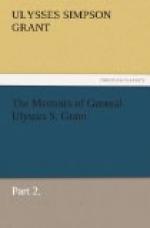The enemy at this time occupied a line running from the Mississippi River at Columbus to Bowling Green and Mill Springs, Kentucky. Each of these positions was strongly fortified, as were also points on the Tennessee and Cumberland rivers near the Tennessee state line. The works on the Tennessee were called Fort Heiman and Fort Henry, and that on the Cumberland was Fort Donelson. At these points the two rivers approached within eleven miles of each other. The lines of rifle pits at each place extended back from the water at least two miles, so that the garrisons were in reality only seven miles apart. These positions were of immense importance to the enemy; and of course correspondingly important for us to possess ourselves of. With Fort Henry in our hands we had a navigable stream open to us up to Muscle Shoals, in Alabama. The Memphis and Charleston Railroad strikes the Tennessee at Eastport, Mississippi, and follows close to the banks of the river up to the shoals. This road, of vast importance to the enemy, would cease to be of use to them for through traffic the moment Fort Henry became ours. Fort Donelson was the gate to Nashville—a place of great military and political importance—and to a rich country extending far east in Kentucky. These two points in our possession the enemy would necessarily be thrown back to the Memphis and Charleston road, or to the boundary of the cotton states, and, as before stated, that road would be lost to them for through communication.
The designation of my command had been changed after Halleck’s arrival, from the District of South-east Missouri to the District of Cairo, and the small district commanded by General C. F. Smith, embracing the mouths of the Tennessee and Cumberland rivers, had been added to my jurisdiction. Early in January, 1862, I was directed by General McClellan, through my department commander, to make a reconnoissance in favor of Brigadier-General Don Carlos Buell, who commanded the Department of the Ohio, with headquarters at Louisville, and who was confronting General S. B. Buckner with a larger Confederate force at Bowling Green. It was supposed that Buell was about to make some move against the enemy, and my demonstration was intended to prevent the sending of troops from Columbus, Fort Henry or Donelson to Buckner. I at once ordered General Smith to send a force up the west bank of the Tennessee to threaten forts Heiman and Henry; McClernand at the same time with a force of 6,000 men was sent out into west Kentucky, threatening Columbus with one column and the Tennessee River with another. I went with McClernand’s command. The weather was very bad; snow and rain fell; the roads, never good in that section, were intolerable. We were out more than a week splashing through the mud, snow and rain, the men suffering very much. The object of the expedition was accomplished. The enemy did not send reinforcements to Bowling Green, and General George H. Thomas fought and won the battle of Mill Springs before we returned.




